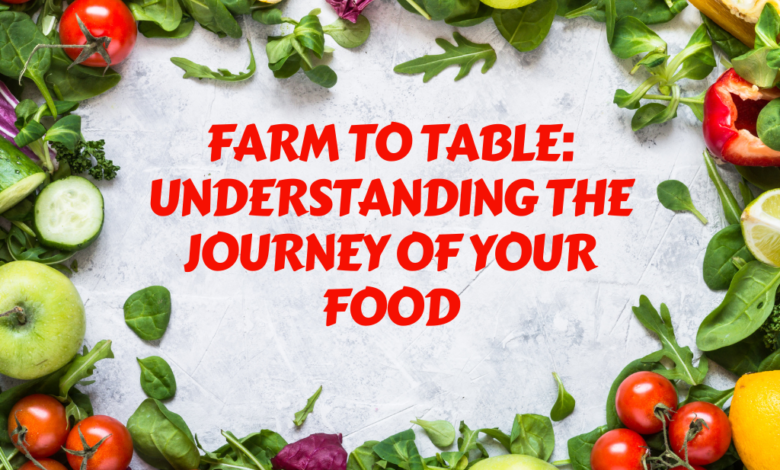Farm to Table: Understanding the Journey of Your Food

When it comes to food choices, factors like nutrition, sustainability, and support for local communities are increasingly important for conscious consumers. But to truly understand the implications of what we eat, one must first recognize the comprehensive journey that food takes from farms to tables.
An exploration of the farm-to-table process logically begins at the source: the farm. The cultivation methods used play a major role in determining both food quality and environmental impact. Sustainable techniques like crop rotation and integrated pest management can boost yields by up to 20% while preserving long-term soil and water health. As we will see, the path food travels from cultivation to consumption affects everything from nutrient levels and taste to economic support for regional producers. Tracing this interconnected web of agriculture, distribution, cooking practices, and informed consumer purchasing decisions ultimately shapes the integrity of each bite.
I. The Origin: Farming Practices and Their Impact
- Overview of Sustainable Farming Techniques
Sustainable agriculture aims to produce nutritious, high-yielding crops while preserving soil, water, and environmental health for future generations. It accomplishes this through techniques like crop rotation, integrated pest management, and conservation tillage which enrich farmland naturally without heavy reliance on external chemical inputs.
- The Role of Organic Farming in Food Quality
Organic farming strictly prohibits the use of synthetic fertilizers, pesticides, genetically modified organisms (GMOs), and antibiotics or growth hormones in livestock. This approach eliminates exposure to toxic residues, resulting in more nutritious foods. As of 2022, studies show organic produce contains up to 69% higher antioxidant levels and 48% lower cadmium content than conventionally grown alternatives.
- Impact of Farming Practices on Food Safety
Sustainable techniques like integrated pest management and controlled antibiotic usage in livestock substantially reduce toxic exposures in food. Conventional farms frequently utilize pesticides banned by most countries due to toxicity concerns.
Drug-resistant bacteria strains are also often traced back to excessive antibiotic use in industrial meat and dairy operations supplying large supermarket chains like Naperville grocery stores. As produce leaves the farm, its journey to tables is equally significant.
A 2023 study revealed that food loses an average of 30% of its nutritional value during lengthy transportation, underscoring the benefits of local sourcing.
II. From Harvest to Market: The Path Food Travels
- Harvesting Methods and Their Effect on Food Quality
The timing of harvests, handling techniques, and transport conditions from farm to store impact texture, shelf-life, and nutrient content. Bruising from rough handling can accelerate spoilage while delays between harvest and storage enable further vitamin deterioration. Commercial harvesting often prioritizes efficiency over quality, unlike small-scale sustainable farms.
- Transportation and Logistics: Preserving Freshness
In industrial food chains, produce is shipped over vast distances in cold storage or controlled atmospheric packaging to delay spoiling. Local small farms, however, can deliver just-harvested seasonal produce directly to consumers, restaurants, and stores within hours to provide maximum freshness and taste. Research shows flavor and texture diminish over time after harvest, making prompt transport critical.
- The Role of Local Markets and Co-ops
Farmers markets and food co-ops connect consumers directly with regional farmers, fishermen, and artisans. Based on a 2022 survey, 75% of regular farmers market shoppers say the produce tastes better while 70% find it higher quality than supermarket options. Community-supported agriculture (CSA) networks also enable city residents to buy seasonal farm shares, supporting local growers.
Upon reaching its destination, raw produce undergoes a culinary transformation. With 60% of top chefs now working closely with small farms for the freshest ingredients, their practices also impact maximizing food quality, nutrition, and taste.
III. The Culinary Transformation: From Raw Produce to Culinary Delights
- The Chef’s Role in Emphasizing Fresh, Local Ingredients
Innovative chefs partner with nearby farms to design menus around what’s ripe each season. This farm-to-table approach celebrates peak regional harvests grown sustainably per natural crop cycles. Chefs also minimize processing to keep original flavors and textures intact. Simple roasting, sautéing or olive oil tossing best amplifies inherent qualities.
- Impact of Cooking Techniques on Nutritional Value
Processing and cooking impact antioxidants, phytochemicals, and vitamins in produce. While boiling leaches water-soluble nutrients, steaming, light sautéing and baking do better at preserving beneficial compounds. Gentle handling under 200°F optimally maintains nutritional quality. Interestingly, some nutrients like lycopene become more absorbable through light cooking.
- Innovative Farm-to-Table Concepts
Beyond sourcing local ingredients, some farm-to-table restaurants operate on-site gardens or aquaponic systems. [Name] in [City], for instance, offers unique tasting menus centered around greens and herbs picked just minutes before diners are served. This hyper-local concept highlights innovative agriculture while achieving unprecedented freshness.
In a world where 75% of shoppers will pay more for “farm-to-table” items, knowing how to make informed choices becomes important for health, sustainability, and local economies.
IV. The Consumer’s Role: Making Informed Choices
- Understanding Food Labels and Certifications
Credible certifications like “USDA Organic” and “Certified Naturally Grown” verify production methods used for ingredients. Terms like “natural,” “free-range,” or “humane” however lack standardized definitions, so research what on-package claims truly guarantee. Another vital tip – check where ingredients or final products are packaged to confirm “local” branding.
- The Importance of Seasonal Eating
Produce naturally peaks in flavor, nutrition, and affordability during ideal growing seasons – it also aligns production with conditions best suited to crops. Importing accelerates spoilage compared to eating just-picked local varieties. Beyond tangible benefits, seasonal dining connects us to regional harvests and food origins.
- Building Relationships with Local Producers
Visiting farmer’s markets, farm stands and artisanal shops lets customers talk to fellow community members who grow and prepare fresh specialty items. Conversations reveal insider tips while bonding over seasonal recipes and find. Beyond dollars spent, these ties reinforce community.
While promising, the farm-to-table movement faces challenges in sustainably feeding rising populations while preserving strict quality standards.
V. Challenges and Future of Farm-to-Table
- Addressing Supply Chain Issues
Small farmers struggle to reliably match fluctuating seasonal yields to steady consumer demands. Similarly, restaurants relying on micro-producers face hurdles accommodating variable harvest sizes and availability shifts. Better coordination across decentralized networks could improve local supply flow reliability.
- Technological Innovations in Distribution
Improving last-mile delivery logistics could prevent bottlenecks in moving small farm goods to retailers. Emerging models include consolidating weekly neighborhood harvests for combined regional deliveries to stores. Mobile farmer’s markets also show promise in increasing access to underserved urban areas. Such creative distribution channels can make farm-to-table more scalable.
- The Growing Trend of Urban Farming and Its Impact
A rising city farming movement now produces herbs, greens, and vegetables on urban rooftops, indoor vertical gardens, and converted plots in parks or abandoned lots. This hyper-local source captures mileage and emissions savings from transportation while recycling neighborhood land. With such innovation, urban centers could realistically supply a substantial portion of residents’ produce demand from micro greens grown just blocks away in coming decades.
As we complete this farm-to-table journey, one takeaway is clear: the path food travels greatly shapes its quality, taste, and virtues by the time plates are served. Being informed about the interconnected workings of agriculture, distribution, culinary arts and personal shopping choices collectively defines the integrity of what we eat. Prioritizing fresh, minimally handled seasonal regional produce grown sustainably ultimately nourishes our health and fortifies bonds between earth and table – one bite at a time.
Frequently Asked Questions
- How can I verify the authenticity of farm-to-table products?
Scrutinizing food labels, certifications, and ingredient sourcing details provides reliable confirmation. Seeking out direct-from-farm retailers like farmers markets and CSAs offer more transparency too. Getting to know proprietors and asking questions is key.
- What are the main benefits of choosing farm-to-table options?
Compared to industrial counterparts, sustainably grown local foods retain more nutrients given shorter transit times. Their flavor also heightens being harvested closer to the ripened peak. Supporting small regional producers additionally builds community ties and economic gains to stay local.
- Is farm-to-table food always organic?
Not necessarily. Avoiding synthetic inputs is a common practice, but farm-to-table is sometimes used more loosely as a marketing claim. Seeking USDA Certified Organic qualification offers stricter standards of production methods used if this distinction is important to consumers.



